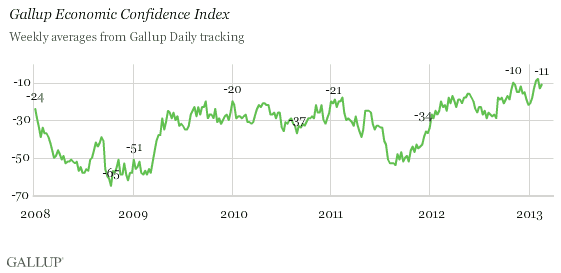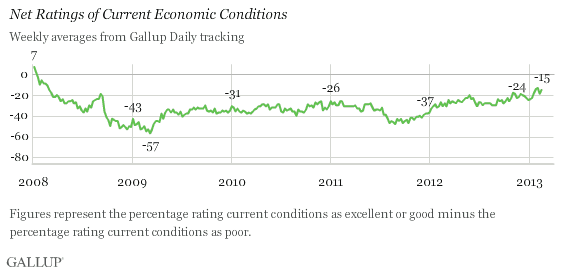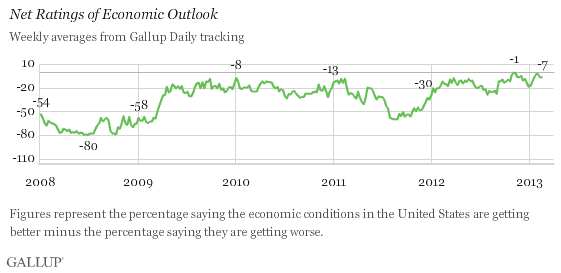PRINCETON, NJ -- Americans continue to remain as upbeat about the economy as they have been at any point in the last five years. Although they are still more negative than positive about the economy overall, their -11 score on Gallup's Economic Confidence Index this past week is three points off the five-year best of -8 from two weeks ago.

The latest weekly average is a two-point improvement over last week's -13, which was down five points from the Jan. 28-Feb. 3 high. The fact that confidence did not decline this past week suggests surging gas prices have not shaken Americans' confidence in the economy yet. Even with high gas prices and the looming battle in Washington, D.C., over the budget sequester, stock values remain high, which could be the most important factor in Americans' stronger economic confidence this year.
Gallup's Economic Confidence Index is based on Americans' ratings of current economic conditions in the United States as well as their assessment of whether the economy is getting better or worse.
Gallup Daily tracking from last week finds 19% of Americans rating current U.S. economic conditions as excellent or good, while 34% say they are poor. That net score of -15 for current conditions compares with -19 from the prior week (18% excellent good and 37% poor) and is one of the more positive readings of the last five years.

The -13 net current conditions score from two weeks ago was the highest since the financial crisis. Prior to that, in early 2008, there were a couple of weeks when more Americans thought the economy was excellent or good than poor.
Meanwhile, 44% of Americans say the economy is getting better and 51% say it is getting worse, unchanged from the prior week. At no point in the last five years have more Americans said the economy was getting better than getting worse. The closest was an average 47% better, 48% worse last fall during the week prior to the presidential election.

The low points in economic outlook generally came during the recession in 2008-2009.
Implications
While there are certainly positive signs for the U.S. economy, such as a strong stock market and indications of a recovering housing market, few would deny that it remains in a fragile state. Experts generally expect economic growth to be modest this year, with potential threats to the economy from scheduled large-scale cuts in government spending and high gas prices.
Nevertheless, Americans' economic mood remains about as good as any point in the last five years. Americans have proven to be generally resilient to potentially challenging economic events such as the fiscal cliff budget negotiations in late December and early January, a reduction in take-home pay for most workers given the expiration of the Social Security payroll tax holiday, and now surging gas prices. Still, the public continues to view the economy more negatively than positively as a whole and continues to rank it as the most important problem facing the country.
Gallup.com reports results from these indexes in daily, weekly, and monthly averages and in Gallup.com stories. Complete trend data are always available to view and export in the following charts:
Daily: Employment, Economic Confidence, Job Creation, Consumer Spending
Weekly: Employment, Economic Confidence, Job Creation, Consumer Spending
Read more about Gallup's economic measures.
View our economic release schedule.
Survey Methods
Results are based on telephone interviews conducted as part of Gallup Daily tracking Feb. 11-17, 2013, with a random sample of 3,576 adults, aged 18 and older, living in all 50 U.S. states and the District of Columbia.
For results based on the total sample of national adults, one can say with 95% confidence that the margin of sampling error is ±2 percentage points.
Interviews are conducted with respondents on landline telephones and cellular phones, with interviews conducted in Spanish for respondents who are primarily Spanish-speaking. Each sample of national adults includes a minimum quota of 50% cellphone respondents and 50% landline respondents, with additional minimum quotas by region. Landline telephone numbers are chosen at random among listed telephone numbers. Cellphones numbers are selected using random-digit-dial methods. Landline respondents are chosen at random within each household on the basis of which member had the most recent birthday.
Samples are weighted to correct for unequal selection probability, nonresponse, and double coverage of landline and cell users in the two sampling frames. They are also weighted to match the national demographics of gender, age, race, Hispanic ethnicity, education, region, population density, and phone status (cellphone only/landline only/both, cellphone mostly, and having an unlisted landline number). Demographic weighting targets are based on the March 2012 Current Population Survey figures for the aged 18 and older U.S. population. Phone status targets are based on the July-December 2011 National Health Interview Survey. Population density targets are based on the 2010 census. All reported margins of sampling error include the computed design effects for weighting.
In addition to sampling error, question wording and practical difficulties in conducting surveys can introduce error or bias into the findings of public opinion polls.
For more details on Gallup's polling methodology, visit https://www.gallup.com/.
